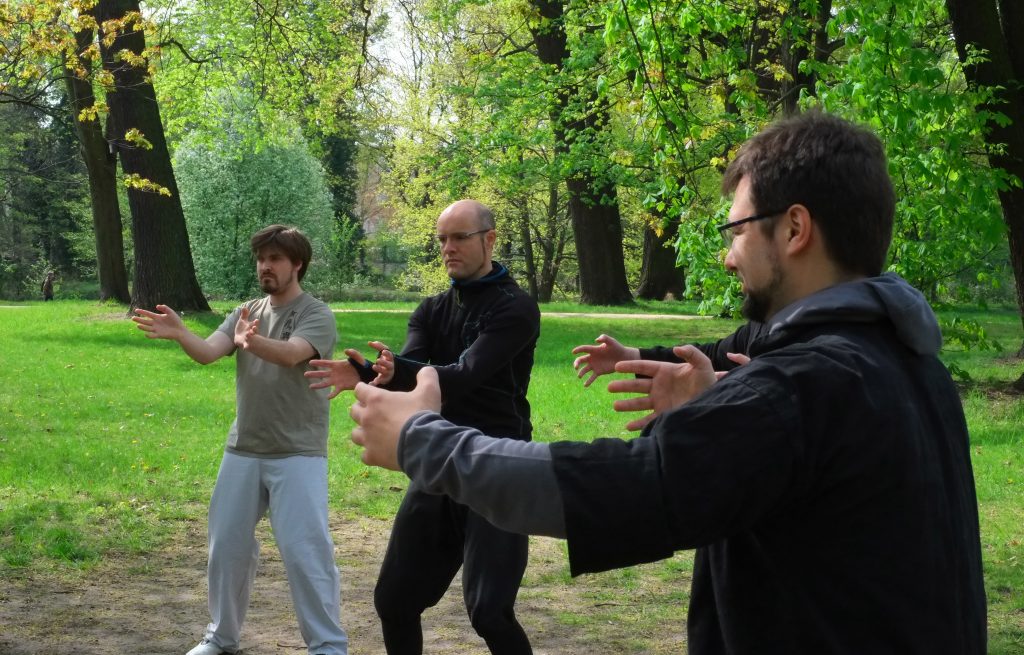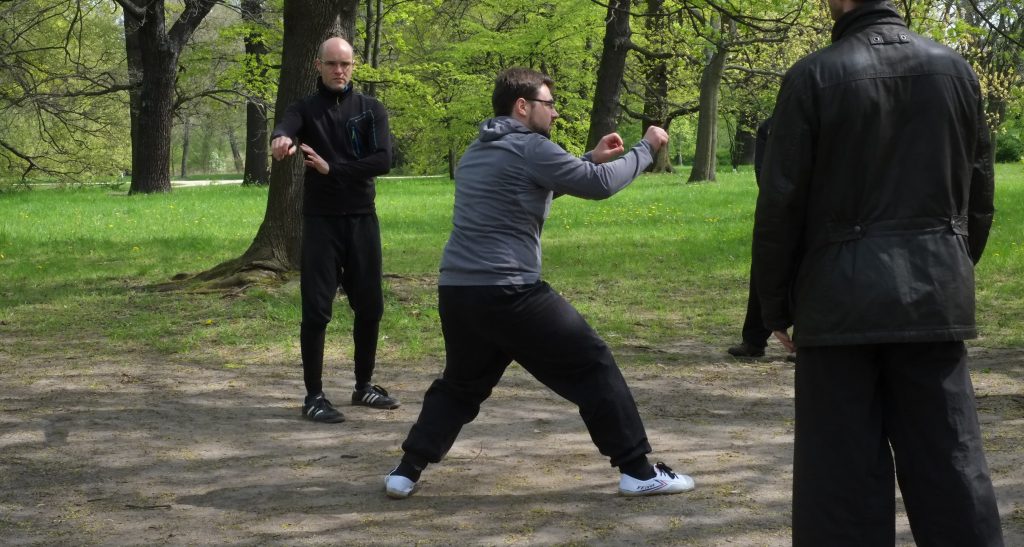Review of the 1st EFeXX Spring Workshop 2016
Author: Daniel Beis
Location: Berlin
Date: 29.4. – 1.5.2016
Host: Zhen Wu Kungfu School
Friday
The first spring workshop of the European Federation for Xin Yi and Xing Yi Kungfu (EFeXX e.V.) started on Friday the 29thof April in the halls of the Zhen Wu Kungfu School, the host of this year’s workshop. The 1st chairman Dr. Daniel Beis opened the workshop with a brief note on the role of scientific heuristics in future projects of the federation. He stressed that for members of the federation it is less important to have a scientific degree, rather it is essential to have a scientific mindset. In particular everyone should carefully handle the questions: (1) From where do I have the knowledge? (Indicate your sources), (2) What can I extrapolate from a particular piece of knowledge? (Be aware of your methodological limitations), (3) When does an opinion become knowledge? (Be critical of your own beliefs). A certain level of Kungfu-experience and level of skill is as important as this scientific attitude and an open mind to generate a respectful and friendly atmosphere.
The first practical session was dedicated to getting a brief glimpse of the “spirit” of Xíng yì quán (形意拳) and Yì quán (意拳). The session was split in half to practice two typical basic exercises, a yīng zhōu (eagle grasp, 鹰周) technique from the Shang Pai Xing Yi Quan and gōu guà (hook and pull) Shili (勾挂试力) technique from the Han Jing Yu Yi Quan. Herein the participants experienced the different methodologies of the two styles and got an outlook on the next days, i.e. to analyze the respective movements and to find the ideas and principles implemented in the particular techniques to discuss similarities and differences.
Afterwards all participants met for some beverages and Indian cuisine to discuss what criteria may be useful to define “Traditional Chinese Martial Arts” (TCMA). TCMA as a technical expression may be helpful to communicate with other disciplines the special conditions that encompass the training of Kungfu-styles such as Xing Yi Quan, Yi Quan, or Xin Yi Liu He Quan. To start the discussion Daniel presented a draft for a scientific definition of TCMA in giving a first approach to differentiate between martial sports and arts, traditional and modern styles, as well as highlighting the problem of defining Chinese martial arts in a historical scope. A proper definition of TCMA is not yet determined; however, several aspects were raised during discussion:
- It may be necessary to highlight the impact of philosophical, historical, and cultural aspects which are transferred within a particular tradition and to find ways to specify the benefit and drawbacks of those traditions for a modern practice of TCMA.
- It may be helpful to differentiate between martial sports and arts concerning their respective major training purposes (e.g. competitions vs. self-cultivation), keeping in mind that both fields have overlapping areas.
- It is important to explicate the martial arts goal of “self-cultivation” in terms of mind-body-training, health improvement, physical training, etc.
- It is necessary to extract the essential Chinese components of those Kungfu styles that make them specifically Chinese, especially the necessity of language competence and philosophical foundations.
Heuristic: from the Greek εὑρίσκω, which means to find or to discover; it stresses the way of approaching a question and how to apply special methods for particular problems.
Methodology: is the logic of how and when and for what a method should be used for a special purpose.
The Shang Family lineage, Shang Pai, was founded my master Shang Yunxiang (尚云祥, 1864-1937), who was a disciple of Li Cunyi (李存义) and was the head of several security and military units.
Shili is a training method to test, feel or “taste” power generation.
Han Jing Yu (韓竟禹) was the son of Han Xing Qiao (韓星橋), one of leading disciples of Wang Xiangzhai (王薌齋).

Saturday
We started the day in the Schloßpark Charlottenburg with some Zhan Zhuang exercises from the Yi Quan lineage created by master Wang. Our guest lecturer explained his understanding of how and why people stand in Yi Quan and demonstrated this training method to experience different lines of power, and compressions and expansions of the body. Afterwards Daniel showed a set of Zhan Zhuang and moving exercises rarely trained in Xing Yi Quan, related to Tiger, Dragon, Monkey and Bear. In the comparative perspective we discussed similarities and differences of the two systems, how they train “movement in stillness” and “stillness in movement”, and how they use mental visualization to enhance physical structure development.
After a short lunch break we proceeded with Daniel’s talk about training theory for TCMA. The purpose of a scientific training theory for TCMA may be primarily based on facilitating communication between trainer, teacher, and students, but not in neglecting the special and highly individual teaching methods of each Kungfu tradition. However, given the hypothesis that all practical Kungfu learning shares similar processes, learning steps, didactics and necessary experiences, there may be some support by science-based disciplines for traditional training. In his talk Daniel explicated a way to analyze movements in three aspects: visible shape (external form, xíng, 形), practical application (shǒu fǎ, 手法), and not-visible purpose (intent, yì, 意) of the techniques. An adjacent theory on how we can overcome communication problems by highlighting one or the other of these aspects was introduced. Given that these aspects do not separate a particular technique, but are only used to focus on particular training fields, this concept was applied to various techniques of the Xing Yi Quan system itself.
In line with the interdisciplinary approach of EFeXX, Aaron Schmidt-Wiegand took over with a field report from his long lasting experiences as a teacher for brass and jazz. He highlighted the didactical issues shared by Jazz and Kungfu. First, both arts have to develop creativity, which can per definition not be taught, however, teachers have to build up atmospheres, where students can experience and develop innovative creativity on a solid technical ability and foundation of skill. Learning by heart is very important to master an instrument/body, however the development of understanding the purpose and to modify, adapt and change these learned skills requires other didactics. As a second field Aaron pointed to the concepts of tempus, pulse, and rhythm, which are highly important for both music and martial arts. Even though many Kungfu styles do not emphasize musical/rhythmical aspects intensively, in every Tào Lù, in partner exercises and solo training students instinctively develop a special preference for speed (tempus), for repetitive patterns (pulse), and some kind of “melody” overlaying both (rhythm). It is important to know that tempus is realized just after two hits (in music or punching), pulse after three hits, but rhythm only after a while.
Connected to these descriptions and the follow-up discussion about similar principles in TCMA we continued with several partner exercises from Yi Quan and Xing Yi Quan to play with the three concepts: tempus, pulse, rhythm. Here, we started to modify one of those aspects to change a rhythmical partner drill into a block, to interfere with the pulse or to negotiate the interaction by acceleration.
For further discussions and nice food we transferred to the Do De Li (多得利) restaurant in the Kantstraße, Berlin, and enjoyed south Chinese cuisine and beverages.
Zhan Zhuang or “Standing like a post” are training exercises that appear highly static, but actually stress subtle movements within the apparent stillness.
Wang Xiangzhai (王薌齋, 1885-1963) was a student of Guo Yunshen (郭雲深) and learned Xing Yi Quan. Later he studied also other martial arts and generated the Yi Quan training method.
Tào Lù (套路) is a prearranged pattern of techniques performed solo or with partners, often translated as shadow boxing.

Sunday
On the sunny Sunday morning we finished the agenda of this workshop by having a look on several interpretations of the so called metal fist or Pi Quan of different styles. We exercised each technique to feel the special way and weighting that different lineages emphasized and discussed the advantages of each variant. Closing up with a summary, we are looking forward to the next meeting which will be announced soon.
About the speakers (not obligatory)
Daniel Beis studied Biomedicine, Philosophy and Psychology. He graduated with a PhD in Neuroscience and worked as a scientist and lecturer for different institutions. Daniel started to train in 1995 with Taiji Quan and Baji Quan, before he shifted to the Xin Yi Styles. He was accepted as an inner door student by Master Li Lee and teaches Shang Pai Xing Yi Quan since then. After Master Lee passed away he became inner door student of Master Lü Yan Zhe and also practices Xin Yi Liu He Quan. Recently he moved to Konstanz to investigate the biopsychological aspects of Yang Sheng Gong and Qi Gong.
Aaron Schmidt-Wiegand is a musician since his youth. He studied musical education at the University for Music, Theater and Media in Hannover with a major trumpet. He teaches music in Berlin, plays in several Jazz and Big Bands, conducts and composes. Aaron gained a variety of didactical experiences during his advanced trainings, e.g. how to teach creativity and improvising (which cannot be taught). He also transported his insights to his martial arts training, which lead him via Judo and Karate to the Chinese Art of Xing Yi Quan since 2010.
